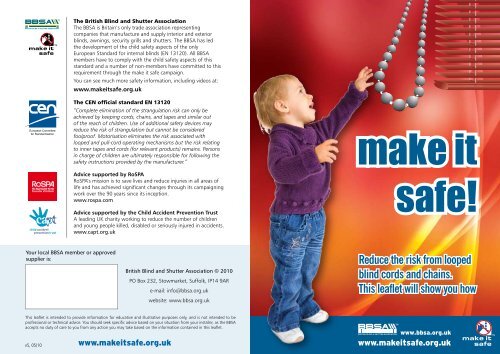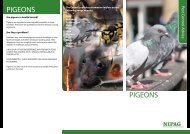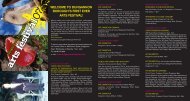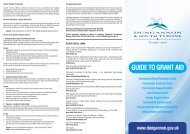Window Blind Cord Safety - RoSPA
Window Blind Cord Safety - RoSPA
Window Blind Cord Safety - RoSPA
Create successful ePaper yourself
Turn your PDF publications into a flip-book with our unique Google optimized e-Paper software.
European Committee<br />
for Standardisation<br />
<br />
<br />
The British <strong>Blind</strong> and Shutter Association<br />
The BBSA is Britain’s only trade association representing<br />
companies that manufacture and supply interior and exterior<br />
blinds, awnings, security grills and shutters. The BBSA has led<br />
the development of the child safety aspects of the only<br />
European Standard for internal blinds (EN 13120). All BBSA<br />
members have to comply with the child safety aspects of this<br />
standard and a number of non-members have committed to this<br />
requirement through the make it safe campaign.<br />
You can see much more safety information, including videos at:<br />
www.makeitsafe.org.uk<br />
The CEN official standard EN 13120<br />
“Complete elimination of the strangulation risk can only be<br />
achieved by keeping cords, chains, and tapes and similar out<br />
of Royal the Society reach for theof children. Use of additional safety devices may<br />
Protection of Accidents<br />
reduce the risk of strangulation but cannot be considered<br />
foolproof. Motorisation eliminates the risk associated with<br />
looped and pull-cord operating mechanisms but the risk relating<br />
to inner tapes and cords (for relevant products) remains. Persons<br />
in charge of children are ultimately responsible for following the<br />
safety instructions provided by the manufacturer.”<br />
Advice supported by <strong>RoSPA</strong><br />
<strong>RoSPA</strong>’s mission is to save lives and reduce injuries in all areas of<br />
life and has achieved significant changes through its campaigning<br />
work over the 90 years since its inception.<br />
www.rospa.com<br />
Advice supported by the Child Accident Prevention Trust<br />
A leading UK charity working to reduce the number of children<br />
and young people killed, disabled or seriously injured in accidents.<br />
www.capt.org.uk<br />
make it<br />
safe!<br />
Your local BBSA member or approved<br />
supplier is:<br />
British <strong>Blind</strong> and Shutter Association © 2010<br />
PO Box 232, Stowmarket, Suffolk, IP14 9AR<br />
e-mail: info@bbsa.org.uk<br />
website: www.bbsa.org.uk<br />
Reduce the risk from looped<br />
blind cords and chains.<br />
This leaflet will show you how<br />
This leaflet is intended to provide information for educative and illustrative purposes only, and is not intended to be<br />
professional or technical advice. You should seek specific advice based on your situation from your installer, as the BBSA<br />
accepts no duty of care to you from any action you may take based on the information contained in this leaflet.<br />
<br />
www.bbsa.org.uk<br />
v5, 05/10 www.makeitsafe.org.uk<br />
www.makeitsafe.org.uk
<strong>Window</strong> <strong>Blind</strong> <strong>Cord</strong> <strong>Safety</strong><br />
<strong>Window</strong> blind cords and chains can pose a risk for babies,<br />
children and vulnerable people who could injure or even<br />
strangle themselves on the hanging looped cords.<br />
You can take a number of practical, simple precautions to significantly reduce the risk.<br />
Make looped cords and chains safe by using one of the available safety devices and by following the information below.<br />
Make sure<br />
all cords and<br />
chains are<br />
always secured<br />
out of reach.<br />
Do not place<br />
your child’s<br />
cot, bed,<br />
highchair or<br />
playpen near<br />
to a window<br />
blind.<br />
Do not put<br />
sofas, chairs,<br />
table, shelves<br />
or bookcases<br />
near to a<br />
window blind,<br />
as children<br />
love to climb.<br />
Typical examples of safety devices are:<br />
Cleat<br />
This should be securely fixed<br />
to an adjacent wall, out of the<br />
reach of children, and the cord/<br />
chain secured as shown, after<br />
each operation of the blind.<br />
<strong>Cord</strong>/Chain Tidys<br />
The following devices are secured to an<br />
adjacent wall and the cords/chains are held<br />
permanently within the device.<br />
“Persons in charge of children are ultimately responsible for following the safety instructions provided by the manufacturer.” EN 13120<br />
New <strong>Blind</strong>s<br />
When choosing new blinds for homes or places where children or vulnerable people live or visit always<br />
look for a blind that does not contain cords or has concealed cords.<br />
Chain-break connector<br />
These will break apart when<br />
undue pressure is applied to<br />
the operating chain.<br />
Wand operated<br />
vertical blinds<br />
Gear operated<br />
blinds<br />
Spring operated<br />
roller blinds<br />
Concealed cord systems where the inner cords of the blinds are<br />
held under tension and there are no operating cords<br />
The accessible cords that run through some blinds can also<br />
pose a risk to children in that it may be possible to form a<br />
loop. Contact your BBSA member or approved ‘make it safe’<br />
supplier or visit www.makeitsafe.org.uk for more information.<br />
<br />
make it safe!<br />
Always consult a BBSA member or<br />
a ‘make it safe’ approved supplier<br />
<br />
They will give you the best possible advice on the most appropriate blinds, many of which<br />
do not contain operating cords. They will also be pleased to give you further information<br />
on ways to make existing blinds safer.
















